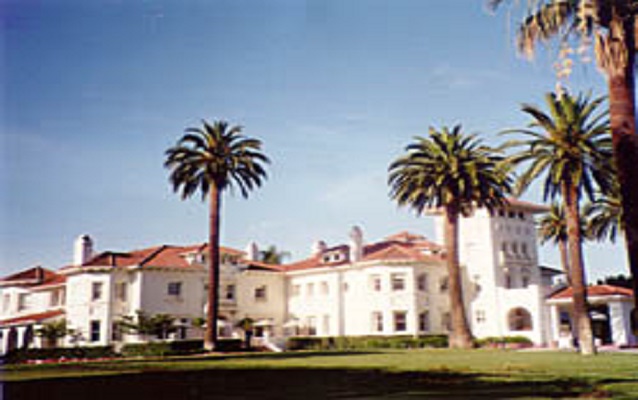Last updated: January 24, 2018
Place
Hayes Mansion

The Hayes Mansion was designed by architect George Page in 1905
The Hayes Mansion was built in 1905 to replace the original Queen Anne style family home, destroyed by fire in 1899. The 62-room mansion, designed by architect George Page, has been referred to as one of the finest examples of late 19th-century architecture in the Santa Clara Valley. It was intended to be a triple residence for Mary Folsom Hayes Chynoweth and the growing families of her two sons, although Mary died before the house was complete. The elegant, 41,000-square foot Mediterranean Villa is built in the form of a Maltese Cross, a long center section containing an 18-foot wide solarium connecting the south wing with the north wing. A loggia connects the east wing with the west wing. Beautiful craftsmanship, imported marbles and exotic woods decorated its large and airy rooms. Although it is not evident, the walls are double brick with stucco coating. As a result of the fire that destroyed the earlier home, the design of the Hayes Mansion included many fire-safety features. Throughout the house there are fire hose cabinets that connect to water tanks on the third floor. The kitchen was located in a separate building and connected to the mansion with a glass and marble plant conservatory.
Mary Folsom was born in 1825 in upstate New York, one of the younger children in a large family. Even though she had little formal schooling, she educated herself sufficiently to pass the state exams for school teachers. At the age of 27 she had a profound religious experience that changed her life forever. In a most unusual move for a woman of her pre-Civil War era, Mary left teaching and traveled from town to town preaching and healing. Mary's parents migrated to Wisconsin and, two years into her ministry Mary visited them. Her parents were living at the home of newly widowed Anson Hayes, caring for his young daughter. With time Mary and Anson fell in love and Anson asked her to marry him. She agreed after he promised to assist her in her work in any way he could. Anson died when their sons, Everis and Jay, were attending college in Madison, Wisconsin. Mary later remarried a San Jose attorney named Thomas Chynoweth. Both of her sons became practicing attorneys and believed in their mother's powers as strongly as she did.
In December 1882, Mary felt that a higher power had guided her sons and herself to invest in certain lands near Ashland, Wisconsin. After establishing themselves in the mining business in Ashland, the Hayes family decided to migrate to California. Settling at this location, isolated from the core of San Jose, the estate was still the center of Santa Clara County society. The Hayes brothers became early San Jose Mercury publishers, prominent valley politicians, and were actively involved in establishing the Santa Clara Valley fruit industry. The family grew their own fruits and vegetables and raised their own livestock, and the Hayes estate became completely self-sustaining. Electricity was supplied by a power plant on the grounds. The property also included a post office, railroad station, carriage stop, men's dormitory for 40 ranch hands, and a chapel. None of these buildings remain today. The families of the two Hayes brothers lived in the mansion until they sold it in the 1950s, after which the villa remained empty and fell into disrepair. In 1994 the mansion was successfully renovated, and it is now a conference center.
